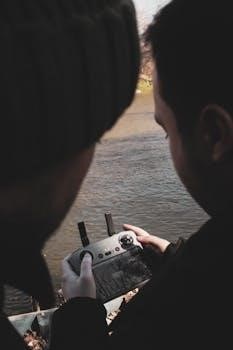hidden intellectualism by gerald graff pdf
Category : PDF
Overview of “Hidden Intellectualism” by Gerald Graff
Gerald Graff’s “Hidden Intellectualism” explores the overlooked intellectual potential found outside traditional academic settings․ He examines how “street smarts” are often dismissed, despite demonstrating significant cognitive skills․ Graff challenges the conventional definition of intelligence․
Central Argument of the Essay
Graff’s central argument in “Hidden Intellectualism” is that the academic world often undervalues and overlooks the intellectual capabilities demonstrated by individuals who possess “street smarts” or engage in non-academic interests․ He contends that these individuals possess a form of intelligence that, while different from traditional book learning, is equally valid and potentially valuable․ Graff suggests that schools often fail to recognize and cultivate this hidden intellectualism, leading to a disconnect between students’ interests and academic pursuits․
He argues that the ability to engage in complex reasoning, critical thinking, and argumentation is not exclusive to those who excel in formal education․ Rather, these skills can be developed and honed through various activities and interests, including those considered “non-academic․” Graff advocates for a broader understanding of intellectualism that acknowledges the diverse ways in which people demonstrate their intelligence and encourages educators to tap into these hidden intellectual resources to enhance learning and engagement․
Graff’s Critique of Traditional Education
Graff critiques traditional education for its narrow definition of intellectualism, which primarily values academic achievement and book learning while dismissing other forms of intelligence․ He argues that this narrow focus creates a disconnect between students’ interests and the curriculum, leading to disengagement and a sense of alienation․ Traditional education, according to Graff, often fails to recognize and cultivate the intellectual potential of students who excel in non-academic areas․
He criticizes the education system for overlooking the critical thinking, problem-solving, and argumentative skills that individuals develop through their passions and interests outside of school․ Graff contends that schools should embrace a more inclusive approach to intellectualism, one that acknowledges the diverse ways in which students demonstrate their intelligence․ He advocates for educators to tap into students’ existing interests and “street smarts” to make learning more relevant and engaging, ultimately fostering a deeper appreciation for intellectual pursuits․

The Concept of “Street Smarts” vs․ “Book Smarts”
This section delves into the dichotomy between “street smarts” and “book smarts,” exploring how society often undervalues the former․ Graff challenges this perception, highlighting the intellectual skills inherent in street smartness․

Deconstructing the Dichotomy
Gerald Graff challenges the conventional opposition between “street smarts” and “book smarts,” arguing that this division is artificial and ultimately harmful․ He posits that the intellectual skills demonstrated in non-academic pursuits are often overlooked and undervalued by traditional educational institutions․ Graff suggests that “street smarts” involve critical thinking, problem-solving, and persuasive communication, all of which are essential intellectual abilities․
He contends that individuals who possess “street smarts” are capable of engaging in complex analysis and argumentation, even if they lack formal academic training․ By deconstructing this dichotomy, Graff aims to broaden the definition of intellectualism and recognize the diverse forms of intelligence that exist beyond the classroom․ He emphasizes the importance of acknowledging and cultivating these “hidden” intellectual abilities to foster a more inclusive and effective educational system․ This approach encourages educators to tap into students’ existing interests and experiences to promote academic growth․
Potential Intellectual Value of Street Smarts
Graff highlights the significant intellectual value inherent in “street smarts,” arguing that these skills often involve sophisticated forms of reasoning and analysis․ Individuals adept at navigating social situations, negotiating, and problem-solving in real-world contexts demonstrate intellectual capabilities that are frequently dismissed by traditional academic standards․ “Street smarts” can encompass a deep understanding of human behavior, the ability to assess risks, and the capacity to adapt to changing circumstances․
These skills require critical thinking, strategic planning, and effective communication, all of which are essential components of intellectual engagement․ Graff suggests that the ability to analyze complex social dynamics and develop creative solutions to practical problems is a valuable form of intelligence that should be recognized and cultivated․ By acknowledging the intellectual merit of “street smarts,” educators can create more inclusive and relevant learning environments that empower students to connect their existing knowledge and experiences to academic pursuits․

The Undervalued Potential of Non-Academic Interests
Graff emphasizes that non-academic interests often possess untapped intellectual potential․ These passions can be valuable avenues for developing critical thinking, research skills, and a deeper understanding of the world around us․
Connecting Interests to Academic Pursuits
Graff advocates for bridging the gap between students’ passions and academic work․ He suggests that educators should leverage students’ existing interests, even those considered non-academic, to enhance engagement and learning․ By tapping into what students already care about, teachers can create a more relevant and meaningful educational experience․
For example, a student passionate about sports could analyze game strategies using mathematical models or research the social and economic impact of professional sports teams․ A student fascinated by fashion could explore its historical evolution, cultural significance, or the ethical considerations of the fashion industry․ The key is to find a connection between the student’s passion and the academic curriculum, transforming seemingly unrelated interests into valuable learning opportunities․
This approach not only makes learning more enjoyable but also helps students develop critical thinking, problem-solving, and research skills that are transferable to other academic areas and future endeavors․ Ultimately, connecting interests to academic pursuits empowers students to become more active and invested learners․
Transforming Street Smarts into Academic Skills
Graff posits that “street smarts,” often dismissed as non-intellectual, possess untapped potential that can be channeled into academic success․ The ability to navigate complex social situations, negotiate effectively, and think critically under pressure, all hallmarks of street smarts, are valuable assets that can be translated into academic skills․
For instance, the persuasive skills honed through street-level interactions can be applied to writing compelling arguments or delivering effective presentations․ The ability to analyze people and situations can be used to interpret literature or understand historical events․ The resourcefulness and problem-solving skills developed in challenging environments can be applied to research projects or complex mathematical problems․
By recognizing and validating these skills, educators can help students see the connection between their lived experiences and academic pursuits․ This can be achieved through assignments that encourage students to draw upon their street smarts, such as analyzing real-world scenarios, debating controversial issues, or developing innovative solutions to community problems․ In essence, transforming street smarts into academic skills involves recognizing the inherent intelligence within these abilities and providing opportunities for students to apply them in academic contexts․

Implications for Education and Pedagogy
Graff’s essay urges educators to recognize and value diverse forms of intelligence, moving beyond traditional academic metrics․ It suggests pedagogical shifts to engage students’ existing interests, bridging the gap between street smarts and book smarts․
Encouraging Diverse Forms of Intellectualism
Gerald Graff’s “Hidden Intellectualism” advocates for a broader understanding of intellectual capabilities, extending beyond conventional academic achievements․ The essay challenges the education system to recognize and cultivate the inherent intellectualism present in diverse, non-academic interests and experiences․
Graff emphasizes that individuals often possess sophisticated analytical and critical thinking skills honed outside the classroom, particularly within their passions and hobbies․ Encouraging diverse forms of intellectualism involves acknowledging the value of “street smarts” and other practical intelligences, rather than dismissing them as anti-intellectual․
Educators should strive to create learning environments that validate and incorporate these varied intellectual strengths․ This approach requires rethinking traditional pedagogical methods and assessment strategies to accommodate a wider spectrum of intellectual expression․ By recognizing and nurturing diverse intellectual forms, education can become more inclusive, engaging, and effective for all students, fostering a deeper appreciation for the multifaceted nature of intelligence․ Graff’s work underscores the importance of valuing intellectual diversity․
Rethinking the Curriculum to Engage Students
To truly engage students, the curriculum must evolve beyond traditional, narrowly defined academic subjects․ Graff suggests incorporating students’ existing interests and passions into the learning process․ This means recognizing the intellectual value of “street smarts” and other non-academic pursuits, and finding ways to connect them to academic concepts․
Instead of dismissing these interests as distractions, educators should leverage them as entry points for critical thinking and analysis․ For example, a student passionate about video games could analyze game design, narrative structure, or the social impact of online gaming communities․ By allowing students to explore academic concepts through the lens of their own interests, the curriculum becomes more relevant and engaging․
This approach requires a shift in pedagogical methods, moving away from rote memorization and towards active learning, discussion, and critical inquiry․ Ultimately, rethinking the curriculum means creating a learning environment where students feel valued, understood, and empowered to use their unique intellectual strengths․
Gerald Graff’s “Hidden Intellectualism” culminates in a powerful call to redefine our understanding of intelligence․ He challenges the narrow, traditional view that equates intellectualism solely with academic achievement and book learning․ Graff argues that intellectual potential exists in diverse forms, often unrecognized and undervalued in formal educational settings․
By recognizing the intellectualism inherent in “street smarts,” non-academic interests, and everyday experiences, we can create a more inclusive and equitable educational system․ This redefined intellectualism acknowledges the critical thinking, problem-solving, and analytical skills developed outside the classroom․
Ultimately, Graff’s work encourages educators to tap into the hidden intellectual potential of all students․ By connecting academic pursuits to students’ passions and interests, we can foster a more engaging and meaningful learning experience․ This shift in perspective not only benefits individual students but also enriches the broader intellectual landscape by valuing diverse forms of intelligence and experience․





